“That's Gotta Be a Pyramid!": A Mound in Ek Balam
Our first Glimpse of The Acropolis in Ek Balam - Travel Tales from the Land of the Maya #7
After spending a few days in Cobá, we drove on early in the morning. Our destination for the night was Piste, the gateway town to Chichen Itza, the next major archaeological site we wanted to visit. So, we didn’t linger in Valladolid, except for a short stop in the zocalo to watch the colorful huipiles local women artisans were selling. The hand-embroidered traditional Maya dresses showcased on the fence surrounding the park in the zocalo added a local charm to the city.
Past the town, we noticed a narrow road leading to a small archaeological site called Ek Balam.
Naturally, we turned onto it. Midday in April, in Yucatan, it’s better to drive if you have an air-conditioned rental car than walk outside in the scorching sun. So, if you find a tiny road in the middle of nowhere, leading to an archaeological site you haven’t heard of, you follow it. At least we did. To this day, we still would.
Welcome back to another installment of Travel Tales from the Land of the Maya, stories.
If you are new here or haven’t read any of the earlier installments, this is the story of my first trip to the Yucatan Peninsula on my honeymoon in 1995. To read the first six installments, click on the link above.
After what seemed like hours driving with not a building in sight, we spotted a small palapa on the side of the road.
As we got closer, we noticed a hammock strung between two poles, under it. A bicycle was leaning against one of the wooden poles holding up the structure.
By the weight of the hammock as it hung, we could tell someone was lying in it. A wooden sign nailed to one of the palapa’s poles told us we had arrived at the archaeological site of Ek Balam.
So the road led somewhere, after all. The palapa was the ticket booth.
As I opened the car door, the muggy heat, heavy and oppressive, hit me. The air was still, with no breeze. Even the insects were quiet.
I didn’t want to get out of the car, just like the person lying in that hammock didn’t seem to want to move. But Jeff was excited. He jumped out of the car and walked into the shade, under the palapa.
His excitement is always contagious. So, as sluggish as I felt, I followed him. The person in the hammock slowly rose and greeted us. We could tell by his features he was indigenous Maya. Our Spanish at the time was almost nonexistent, and he wasn’t speaking any English, but somehow we could still communicate.
When he understood that we weren’t lost, but went off to search for this unknown site, he seemed to get excited, too. After giving us the tickets, he walked us to the site. Unfortunately, the language barrier prevented us from talking much. That, and the oppressive heat, when even talking seemed a chore.
You probably guessed by now, we were the only visitors at the deserted site. And at the time, it wasn’t much to it besides a few structures and mounds of rubble.
As I got used to walking in clothes dripping with sweat, I felt better. I grew excited when I spotted the few structures standing. However, they looked nothing like they do today.
Vegetation had taken over most of the ancient buildings, and the rest were still piles of rubble. Alone with the deserted stones, we climbed every structure, every mound we found. We guessed that underneath our feet stood a pyramid, or another structure.
We climbed the tallest structure cleared at the time, the Oval Palace (across the Acropolis, near the Entrance Arch), where we had a better view of the smaller structures we’ve just walked around after entering the site.
Standing in the center of the ancient city, we noticed a huge mound reaching above the trees.
“Wow! That's Gotta Be a Pyramid!” Jeff exclaimed.
I had to agree; in the flat land of the Yucatan Peninsula, if you see a mound, it’s usually an ancient Maya structure. This one turned out to be even larger than a pyramid, an enormous palace, now known as the Acropolis.
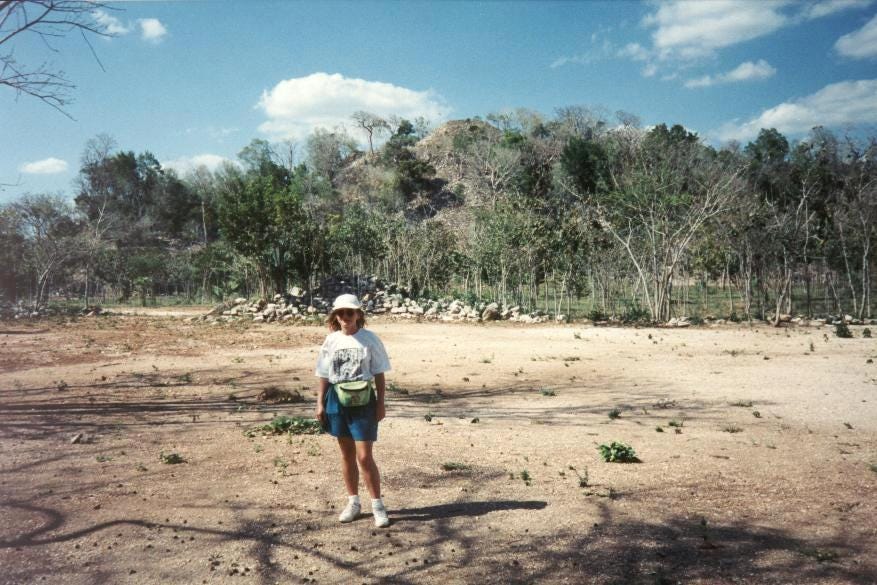
Dripping with sweat, we made our way towards it through the trees. While I was busy “tree-hugging”, touching the bark of the trees so unusual to me, Jeff disappeared ahead of me. Suddenly, I noticed him on top of the mound.
“Come on up!” he yelled when he saw me looking at him.
“How?” I yelled back, after looking around for a trail or at least a relatively easy way up.
“Go around it, the trail is in the back!”
The barely discernible, overgrown trail opened up, and I climbed the Acropolis for the first time, joining my husband on the top.
Here, high above the canopy, we felt like true explorers who found an unexpected treasure (or palace).
A slight breeze cooled us as we stood there in awe, enjoying the view of the barely excavated site and the jungle beyond it.
Eventually, we descended and made our way back towards the entrance.
Along the way, as we wandered off the trail, we noticed a pile of large, cut rectangular stones, some arranged in orderly rows. Many of them were cleaned and numbered, like pieces of a puzzle. Others stood farther in a pile, as if expecting their turn to be fit into the order.
We had found the work in progress of reconstructing the site. Seeing it, we promised ourselves to return a few years later, to see what they had found.
We guessed it would be spectacular. But never expected it to be as beautiful as it is.
We also never expected it to turn into the tourist trap it is today.
Of all the Maya archaeological sites we visited and revisited over three decades, Ek Balam is the most striking example of the changes in both reconstruction and growing popularity of the sites.
Ek Balam (name translated as “Black Jaguar” or “Night Jaguar” ) was a lived-in city from the Middle Preclassic through the Postclassic period of the ancient Maya civilization. Though a few of the structures date from as far back as 100 BC, the city started growing around 700 AD, and reached its height between 770 and 840 AD.
This was the time Ukit Kan Le’k Tok’ was the city’s ruler, whose tomb is in the Acropolis.
In later years, during the Postclassic period, the city’s population decreased, and Ek Balam slowly became deserted.
In recent history, Juan Gutierrez Picon mentioned the site in 1597, when he wrote the Relation de Ek Balam for the King of Spain. He described a site he heard about from the village elders, who told him a great lord called Ek Balam constructed it.
Later, in 1886, Desire Charnay, the French traveler and archaeologist, visited the site. When he described it, he talked about it as a great discovery.
Sylvanus Morley, a well-known archaeologist who studied the Maya sites, visited Ek Balam in 1920, but he didn’t work on it. It took another half a century until archaeologists excavated the site.
Major work started in 1985 by teams led by William M. Ringle and George J. Bey.
They didn’t excavate and restore the central Acropolis until 1997, two years after our first visit. The numbered pile of stones we saw was most likely part of the preliminary work being done on it.
Now, Ek Balam stands as one of the greatest sites in Yucatan, and the Acropolis is the largest (even if not the tallest) structure on the entire peninsula.
I hope you enjoyed reading about a site you may know now as one of the most spectacular and most visited, from before most people knew about it. These types of finds make a traveler feel like an explorer. If I find a place like this now, I won’t post about it. But since this is no secret any longer, in fact, an over-touristed place, I thought it might be nice to learn about it before it was “discovered” by the tourists.
Until next time,
Wishing you all the best, and happy exploring,
Emese






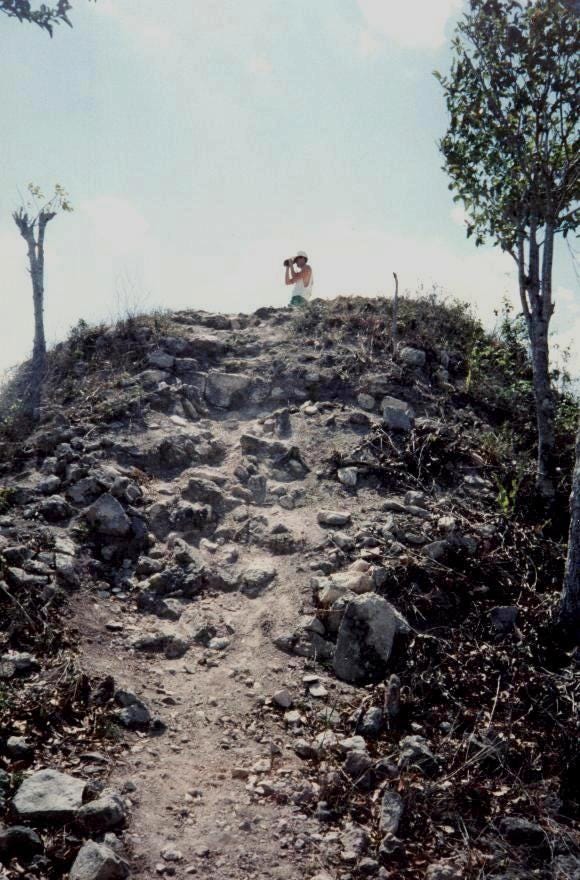
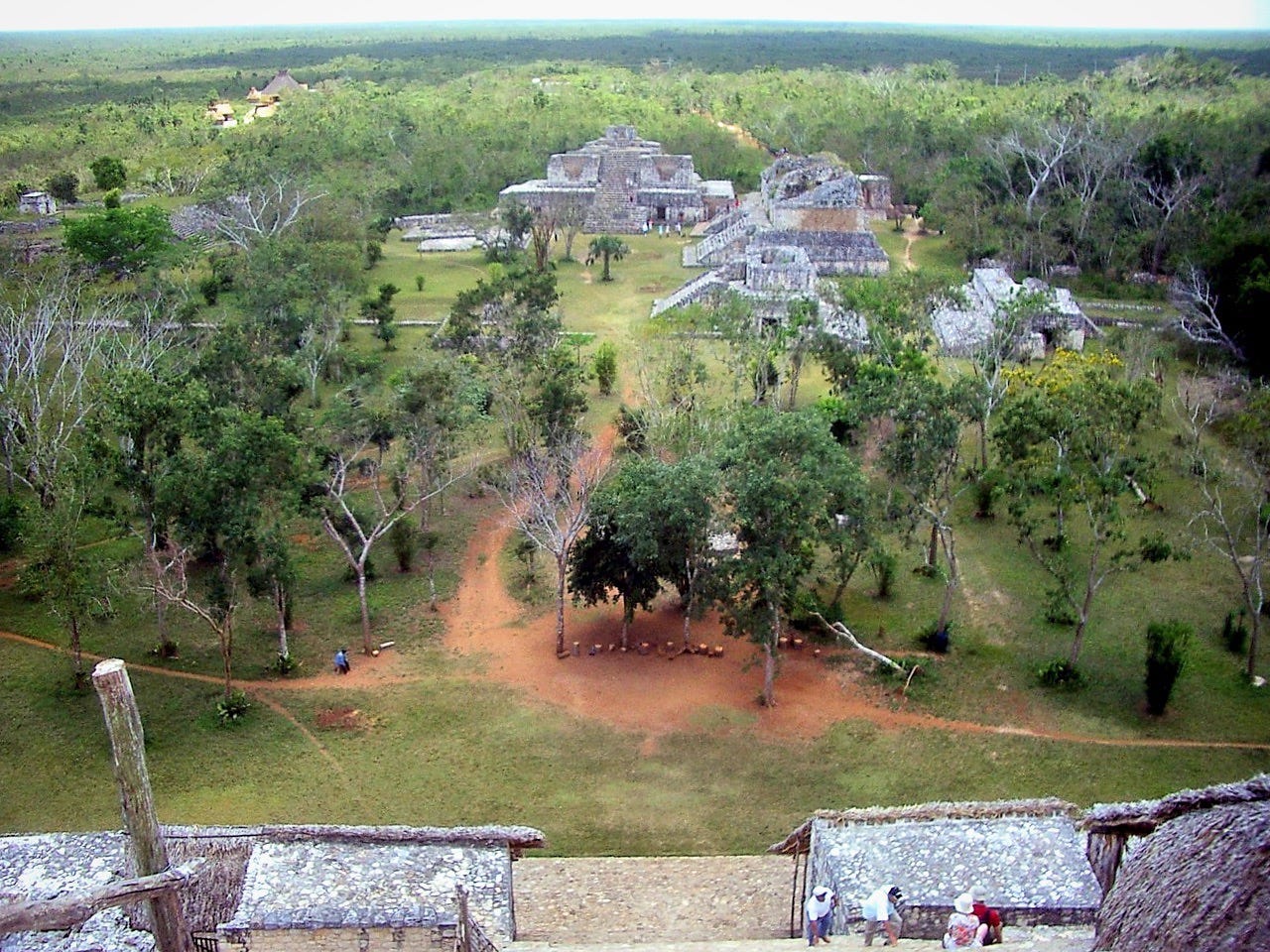
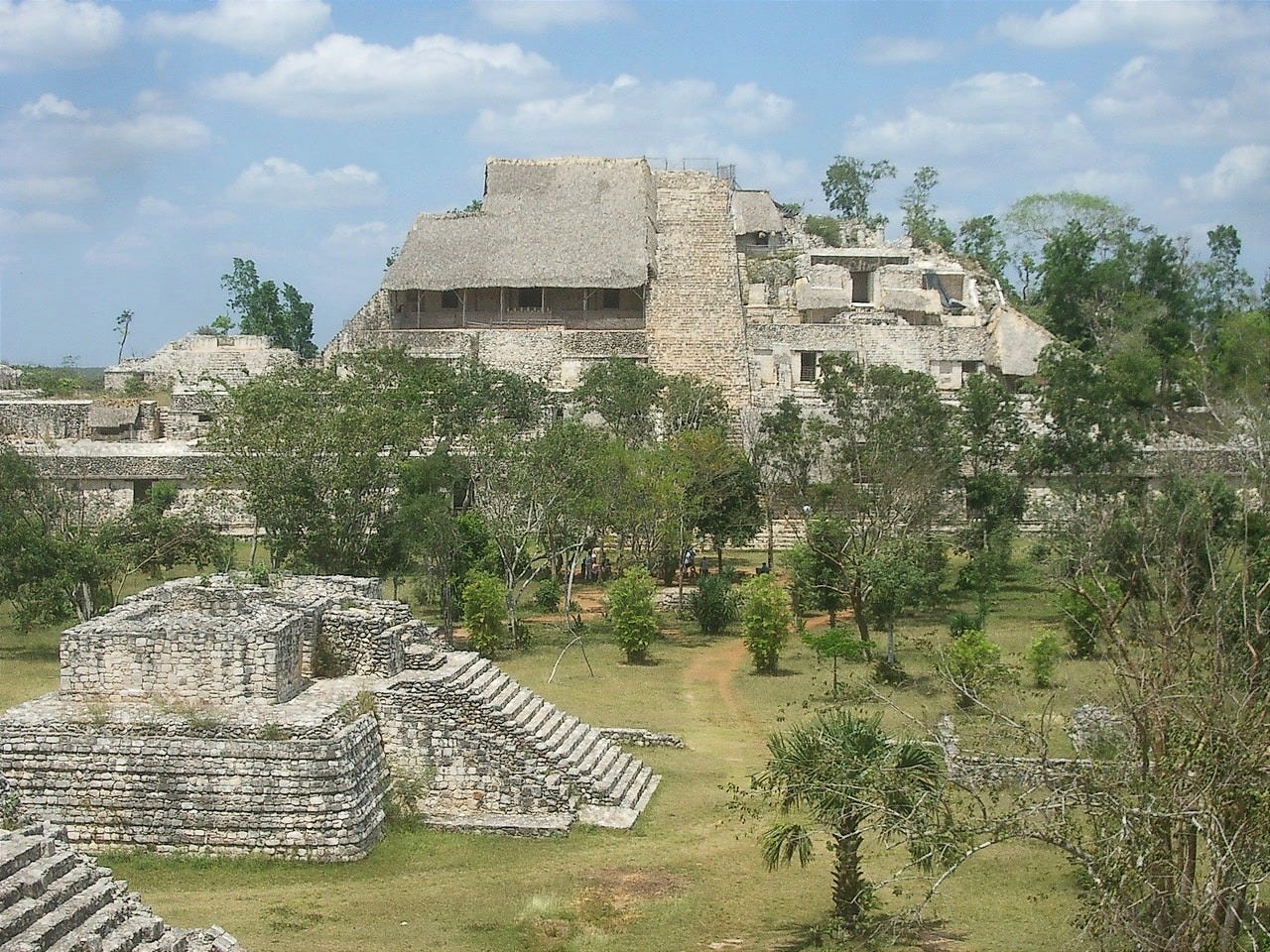
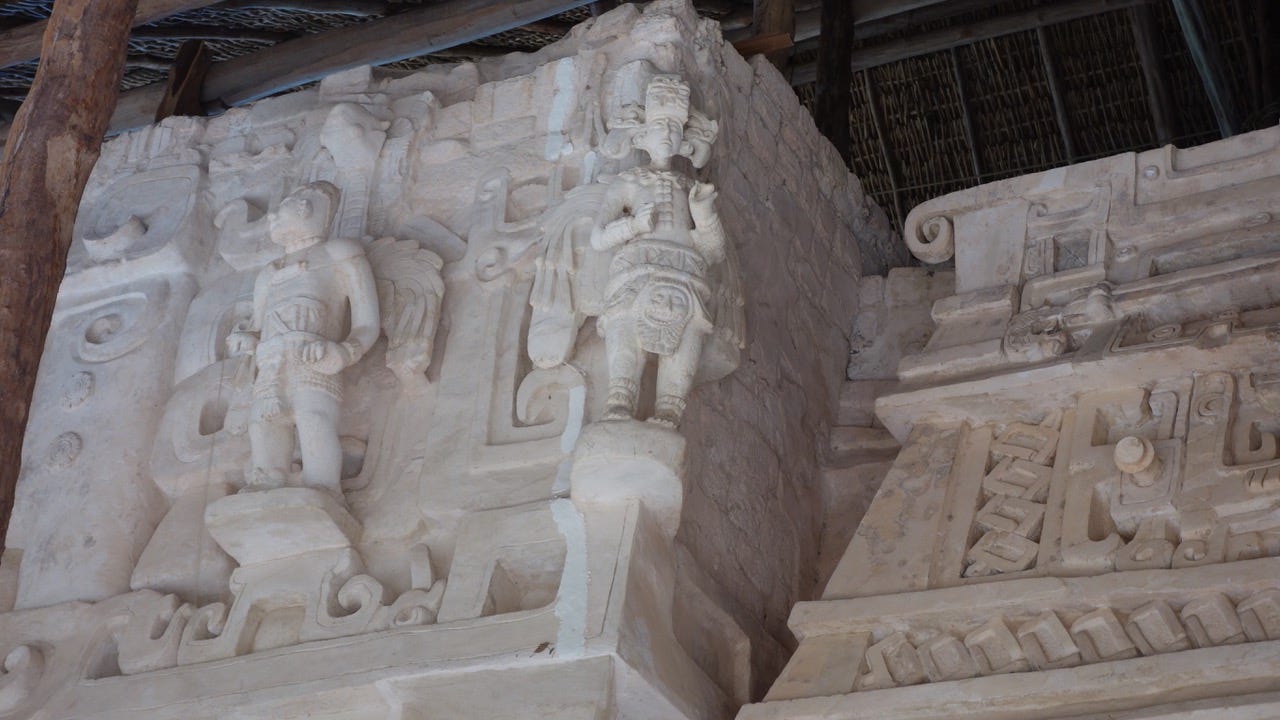
Emese! You saw it in the rough! It is still so amazing, those statues. Really Asian like in appearance (imho). What an adventure!!
Wow definitely need to get there next time we are in the area!